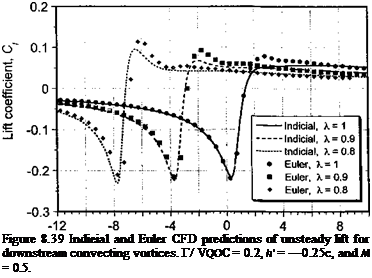Convecting Vertical Gusts in Subsonic Flow
In the subsonic case, the time-varying lift and pitching moment during the penetration of a convecting sharp-edged gust can only be found by numerical means. The problem, however, can be simplified if it is approached by using the reverse flow theorems, as discussed previously; see also Leishman (1997). Results for the lift on the airfoil penetrating a traveling sharp-edged gust at a Mach number of 0.5 are shown in Fig. 8.38 for various gust speed ratios. Results at other Mach numbers are qualitatively similar. Notice that the effect of increasing the gust convection velocity is to increase the rate of buildup of lift, analogous to the incompressible case shown previously in Figs. 8.23 and 8.24. For the subsonic case the center of pressure is always initially forward of the 1 /4-chord as the airfoil penetrates into the gust front, but it moves back quickly again after the airfoil becomes fully immersed in the gust. After only a short time, the aerodynamic center is fully at the 1 /4-chord.
Lift and pitching moment results for convecting sharp-edged gusts in subsonic flow have also been computed by Singh & Baeder (1997b) using an Euler CFD method. Representative
results for the lift are shown in Fig. 8.38 for a Mach number of 0.5 and for several gust speed ratios. Notice that in the early period where s < 2M/(1 + M), or 0.67 semi-chords at this Mach number, the lift varies almost linearly with time as predicted by the exact subsonic linear theory, the rate of growth increasing with increasing gust convection velocity. The comparisons are excellent and lend significant credibility to the CFD results, which can provide valuable solutions for later values of time where exact analytic solutions are not possible. Like the incompressible results, the CFD results predict an initial lift overshoot for s > 2M/(1 + M) that reaches a peak when the airfoil is about halfway into the gust.
To use the indieial method to examine arbitrary convecting vertical gust problems, the convecting sharp-edged gust solutions must be approximated by exponential functions. One suitable exponential approximation to the lift produced on an airfoil encountering a convecting sharp-edged gust is
![]() Ci{s)
Ci{s)
w0/V
where all the coefficients will, in general, be Mach number dependent. To satisfy the initial conditions at 5 = 0 then <7/ = 1- Also, g,- > 0 for і = 1,…, N + 2. The transient shown in the lift response at small values of time for fast traveling gusts is represented by the second two terms in Eq. 8.198, where the coefficient GN+i and the differences in the values of the time constants g#+1 and gw+2 will affect the size and width of this transient. Physically, this transient is a result of the accumulation of pressure waves. In the limit when A -» 0, the magnitude of the transient approaches the piston theory value of 4/М. Results of this procedure are shown in Fig. 8.38 for several gust speed ratios at a Mach number of 0.5. It is seen that while an exact fit to the initial transient at smaller values of A cannot be obtained, an acceptable level of accuracy is possible for values of A that are not too far from unity.
 |
The problem of convecting vortices on the unsteady lift and noise generation has been addressed by Singh & Baeder (1997b) and Leishnian (1997). Results for the unsteady lift on the airfoil for the same conditions of Fig. 8.37 are shown in Fig. 8.39 for several gust speed
Distance-traveled in semi-chords, s
ratios. The results are all referenced to the к = 1 case, so that for downstream traveling vortices the ВVI encounter occurs progressively earlier in time (or distance). We see that an increase in vortex convection speed (decrease in k) progressively increases the peak-to – peak value of the unsteady lift, but more importantly, increases the time rate of change of lift. This will be reflected in the corresponding acoustic field, where the BVI sound pulse (see Fig. 8.48) will increase significantly in magnitude even for values of к not too much lower than unity. Figure 8.39 also shows results for the BVI problem as computed directly using the Euler СГО method; the correlation of the indicial results with the Euler solution is excellent. Overall, these results confirm that the gust speed ratio of the tip vortices in the rotor wake will be a necessary parameter to account for in helicopter blade unsteady airloads and aeroacoustics analyses.











